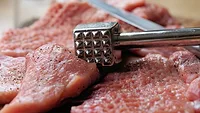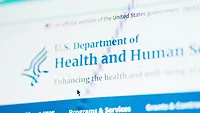Cultivated Meat: How FDA and USDA are Addressing Food Safety

Image credit: Mindful Media/E+ via Getty Images
Concerns around food safety and scalability have surfaced since the successful launch of cultivated meat products in the U.S. For example, a spring 2023 Wall Street Journal article1 noted that cultivated meat makers are in a "battle against bacteria." Safety is, of course, paramount, and U.S. food regulators have collaborated with academics, global food regulators, and cultivated meat developers to establish an approach to safety within the existing regulatory framework—all with an eye toward ensuring that foods developed through cell culture technology are safe and wholesome.
Indeed, the U.S. Food and Drug Administration (FDA) and the U.S. Department of Agriculture's Food Safety and Inspection Service (USDA's FSIS), the food regulators charged with overseeing the safety of the American food supply, developed a Formal Agreement2 in 2019 to leverage their respective expertise as provided for under existing federal statutes covering food safety. This article summarizes recent regulatory developments that provide insight on how the current U.S. regulatory framework addresses food safety within the cultivated meat space.
What is Cultivated Meat?
Cultivated meat, also known as cultured meat or cell-cultured meat, refers to animal meat (including seafood) produced ex vivo—grown outside the animal. This production method removes animal slaughter from the production process. Each company's manufacturing process for animal cell-based food products varies, in part, depending on the type of cell line used (e.g., livestock, poultry, or seafood) and the nature of the final product (e.g., nuggets or steak). At a high level, the key manufacturing stages3 include:
- Target tissue or cell procurement, selection, isolation, preparation, and storage
- Cell proliferation, as well as possible cell differentiation, during biomass production (in a specially designed bioreactor)
- Cell harvesting
- Processing and formulation of food products.
Each stage can include various sub-steps that are dependent upon on the source and desired final food type. Manufacturers aim to produce a finished product that replicates the characteristics of muscle harvested from food-producing animals.
Who Regulates Cultivated Meat in the U.S.?
FDA and FSIS regulate cultivated meat. The 2019 Formal Agreement2 outlines their respective regulatory roles. In short, FDA oversees cell collection, cell banks, and the process of cell proliferation and differentiation for all food made with cultured animal cells.
For FSIS-regulated foods like cultivated chicken, pork, and beef, FSIS oversight begins at the point of harvest—i.e., when the cultured animal cells are removed from their growth environment for further processing. For example, cultivated chicken cells would be subject to FDA oversight until the point of harvest. At the point of harvest and for all post-harvest oversight, FSIS oversees further processing and labeling under its existing authorities to inspect meat and poultry processing establishments and to review and approve labels.
Looking for quick answers on food safety topics?
Try Ask FSM, our new smart AI search tool.
Ask FSM →
For all other cultivated foods falling outside of FSIS oversight—such as most seafood and any meat from non-USDA-amenable species (like elk, deer, antelope, and certain other species), FDA maintains oversight for the entirety of the production process.
How are FDA and FSIS Addressing the Safety of Cultivated Meat?
Below are key, non-exhaustive ways in which FDA and FSIS proactively address the safety of cultivated meat:
- FDA Pre-Market Consultations: FDA has created a voluntary pre-market consultation process known as Cell Culture Consultation ("CCC") to evaluate the safety of food made from cultured animal cells. FDA's public statements explain how this process allows producers to work with the agency prior to market entry, on a product-by-product basis, and in an iterative manner to address the range of issues relevant to producing safe food that conforms to the Federal Food, Drug, and Cosmetic Act and to existing regulations.
- What FDA Reviews in a CCC: Based on the two successful CCCs to date, we can see that FDA reviewed information on cell collection, the cell line and cell bank, cell growth and differentiation, and, importantly, hazard analysis and food safety control measures for every step of the production process. FDA also considers the identity and composition of the harvested cells, including any potential residues or byproducts from the production process and specifications for various food contaminants.
- FDA's Response to a CCC: At the conclusion of a CCC, a successful company will receive a No Questions Letter (NQL). The NQL is not an approval in any way. Rather, it simply states that, as of the date of the letter, FDA has no questions regarding the company's conclusion that its cultivated food is safe and advises that the company has a continuing responsibility to ensure the food is safe.
- FSIS Grant of Inspection: FSIS will issue a federal grant of inspection to a cultivated meat or poultry producer following the developer's successful completion of the FDA CCC process, assuming the establishment completes the necessary steps and satisfies conditions to obtain a federal grant of inspection. All cultivated meat establishments holding a federal grant of inspection are subject to the inspection of their harvest and processing operations. FSIS will inspect operations at a minimum of once per shift (consistent with FSIS' approach to inspection for conventional meat and poultry processing facilities).
- FSIS' Summer 2023 Updates for Cultivated Meat: In Summer 2023, FSIS released FSIS Directive 7800.1,4 FSIS Directive 5730.1,5 and FSIS Notice 31-236 to further detail the agency's approach to overseeing the safety of cultivated meat products. For example, FSIS Directive 7800.14 makes clear that FSIS inspectors will verify a cultivated meat establishment's compliance with existing sanitation and Hazard Analysis and Critical Control Points (HACCP) requirements currently applicable to conventional meat and poultry products. Additionally, pursuant to FSIS Notice 31-23,6 FSIS will test samples for aerobic count, Salmonella, and Listeria monocytogenes, among other food safety parameters.
- FSIS Imports: FSIS has stated that it will allow only imports of cultivated meat and poultry products from countries with inspection systems found to provide an equivalent level of public health protection as is provided by the U.S. system for such products. At present, FSIS is developing procedures for determining equivalence for the inspection of cultivated meat and poultry.
- Substances Must Be Safe and Suitable: For cultivated foods under FSIS oversight, all ingredients (including processing aids) used pre-harvest that remain in the harvested cells and any ingredients used post-harvest must be considered safe and suitable for use by FSIS.
Takeaways for Food Safety Professionals
As cultivated meat companies proliferate in the U.S. and around the world, we anticipate a new round of regulatory approvals from global regulators. As these product offerings continue apace in the short term, and as with any new technology, questions will abound. On the question of safety, however, it is important to underscore that FDA and FSIS have moved at record pace to develop a sound regulatory framework to provide for the production of cultivated meat that is safe and wholesome.
As cultivated meat moves to market in the coming years, the authors anticipate that FDA and FSIS will continue to conduct research into the science and provide additional clarity on regulatory oversight and expectations to producers and consumers on this novel technology. FDA and FSIS must leverage existing law for the benefit of the American consumer and work to ensure that all foods developed through cultivated meat technology are safe for consumption. In the short term, the authors expect FDA to publish draft guidance on its premarket consultation review process. We also anticipate further guideposts to be issued from FSIS as the cultivated meat industry continues to grow.
- 1 Peterson, K. and J. Newman. "Inside the Struggle to Make Lab-Grown Meat." April 23, 2023. Wall Street Journal. https://www.wsj.com/articles/inside-the-struggle-to-make-lab-grown-meat-12cf46ab.
- U.S. Department of Agriculture Food Safety and Inspection Service (USDA FSIS). "Formal Agreement between the U.S. Department of Health and Human Services Food and Drug Administration and U.S. Department of Agriculture Office of Food Safety." March 7, 2019. https://www.fsis.usda.gov/sites/default/files/media_file/2020-07/Formal-Agreement-FSIS-FDA.pdf.
- Food and Agriculture Organization of the Unites Nations (FAO) and World Health Organization (WHO). "Food Safety Aspects of Cell-Based Food." 2023. https://apps.who.int/iris/rest/bitstreams/1495370/retrieve.
- USDA FSIS. "FSIS Responsibilities in Establishments Producing Cell-Cultured Meat and Poultry Food Products." June 21, 2023. https://www.fsis.usda.gov/policy/fsis-directives/7800.1.
- USDA FSIS. "Responsibilities in Dual Jurisdiction Establishments—Revision 1." June 21, 2023. https://www.fsis.usda.gov/policy/fsis-directives/5730.1.
- USDA FSIS. "Updated: Cell-Cultured Meat and Poultry Food Products Sampling Program." June 29, 2023. https://www.fsis.usda.gov/sites/default/files/media_file/documents/31-23.pdf.








